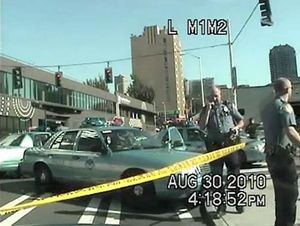
EXCELLENT article from Jennifer Shaw of the ACLU discusses the King County inquest process. Her recent posting to the ACLU blog discusses the King County inquest process. There is a lot of confusion about inquests: what are they, who can participate, what findings can the jury make? This short article addresses some of those questions.
Shaw approaches the subject by discussing how King County District Court will hold an inquest into the August 30, 2010, fatal shooting of First Nations carver John T. Williams by Seattle Police Officer Ian Birk. She discusses how inquests are just one step in the complicated process that begins when a Seattle police officer fatally shoots someone. “While each step can add some information to the picture, the process is cumbersome and not necessarily satisfying to the public,” says Shaw.
The first step after a fatal shooting is the criminal investigation. The next step is to present the case to the Firearms Review Board. The Board reviews the shooting to determine whether it was “justified.” A shooting is considered “justified” if the officer followed the department’s policies and training when he used his weapon.
“That doesn’t mean the officer will be found guilty,” says Shaw. “The board’s decision only means that the officer didn’t follow SPD policies or training. Period. It doesn’t declare that the officer committed a crime or would be found civilly liable or could even be fired.”
The next step is the inquest. An inquest looks a lot like other trials, with a judge, a jury, lawyers, witnesses, court reporter, and observers. But it is not. After hearing evidence about “when, where and by what means” the person died, and listening to follow-up questions from both sides, the six-person jury simply answers a series of yes-and-no questions.
The jurors will not hear evidence about the officer’s training or whether he had alternatives to firing his gun. The attorneys cannot argue their opinions of the evidence to the jury. They cannot ask the jury to find the officer guilty or not guilty. The jury is not permitted to answer whether any person or agency is civilly or criminally liable.
Shaw says the inquest process offers the public an interesting early view of the evidence, but the value of process is limited. The jury cannot determine whether the officer acted reasonably or whether he had alternatives to using his weapon. The jury cannot determine whether the department’s policies or the officer’s training was flawed. Because of these limitations, the inquest process has been frequently criticized by surviving families and advocates, including the ACLU.
After the criminal investigation is complete, the Seattle Police Department’s Office of Professional Accountability will investigate the shooting to determine whether the officer violated department policies and may recommend discipline. The OPA and the OPA Auditor may also recommend policy and training changes.
“Let’s hope that along the way justice is finally served and that significant changes are put in place so that an incident like this never happens again,” says Shaw.
My opinion? I agree with Shaw’s concerns. The inquest process needs significant retooling. It violates the appearance of fairness to have a prosecutor – who shares a naturally symbiotic relationship with police officers – conduct an inquest. It’s unfair that an attorney cannot represent the family of the victim at these proceedings.
It’s unfair that the jury cannot determine whether the officer acted reasonably or whether he had alternatives to using his weapon. It’s unfair that the jury cannot determine whether the department’s policies or the officer’s training was flawed. Clearly, the scope of the inquest must be broadened. Otherwise, it will continue to be a mere formality offering the mere appearance of justice.
Please contact my office if you, a friend or family member are charged with a crime. Hiring an effective and competent defense attorney is the first and best step toward justice.










